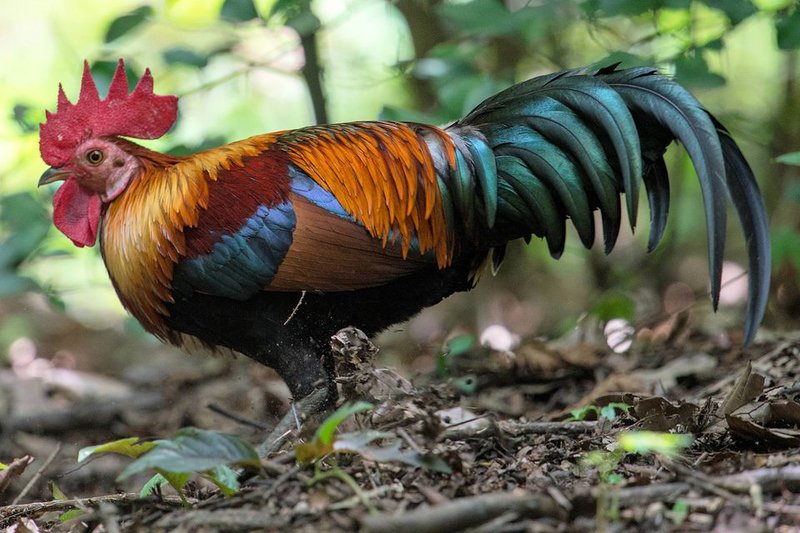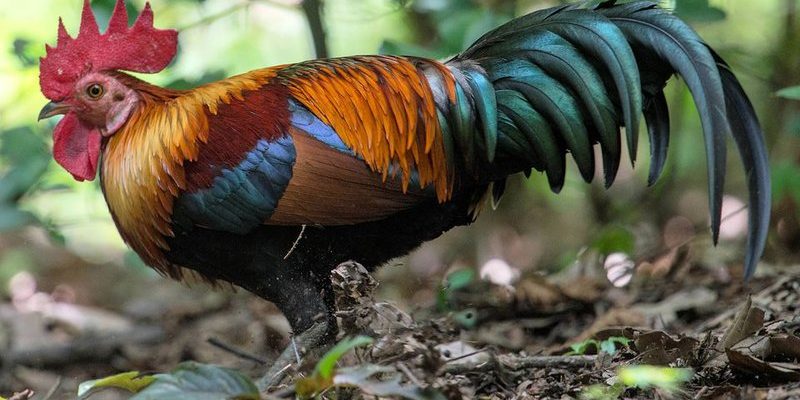
Introduction to Junglefowl
Junglefowl, those vibrant and fascinating birds, are often overlooked in the grand scheme of wildlife. Imagine stepping into a lush jungle, where the air is thick with humidity, and the sounds of nature dance around you. Among the rustling leaves and vibrant flora, you might catch a glimpse of a Junglefowl, strutting confidently through the underbrush. With their striking plumage and unique behaviors, these birds are a delightful sight, and they play a crucial role in their ecosystems.
You might be wondering what makes Junglefowl so special. Well, these birds are not just pretty faces; they are the ancestors of domesticated chickens and have some interesting characteristics that set them apart. Found primarily in Southeast Asia, they thrive in dense forests and shrublands. Their adaptability to various habitats makes them a compelling subject for bird enthusiasts and nature lovers alike. Let’s dive deeper into the world of Junglefowl and uncover their secrets.
What Are Junglefowl?
Junglefowl belong to the genus Gallus, which includes several species, the most well-known being the Red Junglefowl. This beautiful bird is often recognized for its bright red comb and striking iridescent feathers. Besides the Red Junglefowl, there are other species like the Grey Junglefowl, Green Junglefowl, and Sri Lankan Junglefowl. Each has its own unique features and behaviors, making them a diverse group worth studying.
These birds are typically medium-sized, ranging from 50 to 70 cm in length. What’s remarkable about Junglefowl is their sexual dimorphism, meaning males and females look quite different. Males are adorned with vibrant colors and long tails, while females are generally more subdued, sporting browns and tans for excellent camouflage. This coloration helps the females blend into the foliage, especially when nesting.
One of the essential aspects of Junglefowl is their social structure. They are gregarious birds that often form small flocks. Within these groups, you’ll find an interesting hierarchy, often dominated by a leading male who keeps watch over his females and territory. This social behavior not only aids in survival but also helps maintain their breeding grounds.
Physical Characteristics of Junglefowl
In the world of avian beauty, Junglefowl are true showstoppers. The male Red Junglefowl, for instance, boasts a stunning palette of shimmering golds, deep reds, and rich greens. The combination of colors is not just for looks; it’s a crucial part of their mating display. The more vibrant a male appears, the more attractive he is to potential mates. This visual appeal plays a vital role in their reproductive success.
Junglefowl have strong, muscular bodies suited for foraging on the forest floor. Their legs are built for running quickly to evade predators, while their sharp beaks are perfect for scratching the ground in search of food. You’ll often find them searching for seeds, fruits, and small insects, making them important players in their habitats as seed dispersers.
Another fascinating feature is their fascinating vocalizations. Each species of Junglefowl has a distinctive call that can range from soft clucks to loud crows. These calls serve various purposes, including attracting mates, signaling danger, and maintaining communication within the flock. The sounds of Junglefowl often echo throughout their habitats, adding to the symphony of the jungle.
Habitat and Distribution
Junglefowl primarily inhabit the dense forests and shrublands of Southeast Asia, but they also thrive in different environments beyond the jungle. You may find them in places like grasslands and even agricultural areas, where they can take advantage of food sources created by human activities. Their adaptability is impressive, allowing them to flourish in both wild and semi-domesticated settings.
The Red Junglefowl, the most common species, is native to countries like India, Myanmar, and the Andaman Islands. On the other hand, the Grey Junglefowl is typically found in the forests of India and Sri Lanka, while the Green Junglefowl is native to Java and parts of Indonesia. Each species has specialized in its own niche within its specific environment, demonstrating the beauty of evolution.
When it comes to nesting, Junglefowl prefer to create their homes in thick underbrush. This not only provides safety from predators but also offers a prime feeding ground. Females usually lay about 5 to 10 eggs in a nest lined with grass and feathers, a cozy spot for their future chicks. The incubation period is around 21 days, after which the chicks are ready to explore their new environment.
Diet and Feeding Habits
Junglefowl are omnivores, which means their diet comprises both plant and animal matter. They enjoy a varied menu that includes seeds, fruits, insects, and small invertebrates. This diverse diet not only keeps them healthy but also helps in maintaining the ecological balance of their habitats. By eating fruits, they contribute to seed dispersal, aiding in forest regeneration.
When foraging, you’ll often see them scratching at the ground with their strong legs, searching for hidden treasures. They have keen eyesight, which helps them spot potential meals quickly. This behavior is essential, especially in areas where resources may be limited. Junglefowl are active during the day, taking advantage of the sunlight to hunt and gather food.
Interestingly, Junglefowl also have a communal feeding behavior. When they find a good source of food, they will call others in their group to join. This not only fosters social bonds but also increases the chances of locating other food sources. It’s a team effort, showcasing their social nature in the wild.
Reproduction and Life Cycle
The breeding season for Junglefowl typically occurs during the warmer months, coinciding with an abundance of food. Males will establish territories and begin their courtship displays, showcasing their colorful plumage and impressive vocalizations. You might witness a captivating dance as they strut around, puffing out their chests and raising their tails to attract females.
Once a female is wooed, courtship leads to mating. After mating, the female will begin to build a nest, often in dense undergrowth to keep her eggs safe. The typical clutch size ranges from 5 to 10 eggs, and the female will incubate them for about three weeks. During this time, she rarely leaves the nest, relying on her camouflaged body to avoid predators.
Once the chicks hatch, they are precocial, meaning they are relatively mature and mobile right from the start. They quickly learn to forage for food under their mother’s watchful eye. The chicks grow rapidly, and within a few months, they’ll be nearly independent. Junglefowl can live up to 5 to 10 years in the wild, depending on their environmental conditions and predation risks.
Conservation Status
While Junglefowl are not currently facing critical threats, habitat loss due to deforestation and urbanization is a primary concern. As jungles and forests are cleared for agriculture and development, these beautiful birds find their homes disappearing. This not only affects their populations but also disrupts the delicate balance of their ecosystems.
Conservation efforts are increasingly important to protect these species and their habitats. Many organizations are working to raise awareness about the importance of preserving natural environments. By creating protected areas and promoting sustainable land use, we can help ensure that Junglefowl and countless other species continue to thrive.
In addition to habitat preservation, there is also a focus on educating local communities about the ecological role of Junglefowl. By understanding their significance, people can better appreciate and support conservation initiatives. It’s a collective effort to safeguard these colorful birds and the ecosystems they inhabit.
Interesting Facts About Junglefowl
Junglefowl are not just visually stunning; they are also filled with quirky behaviors and fascinating traits. For instance, did you know that the Red Junglefowl is considered the ancestor of all domestic chickens? This connection has significant implications for our understanding of domestication and animal husbandry. Farmers have bred different chicken breeds over time, but they all trace their lineage back to Junglefowl.
Another intriguing fact is that Junglefowl are known for their impressive adaptability. They can thrive in both wild settings and in close proximity to human settlements. This adaptability not only showcases their resilience but also highlights their importance in agricultural ecosystems. In many rural areas, Junglefowl help control insect populations and contribute to biodiversity.
Their vocal abilities are equally remarkable. Each species not only has its distinct calls, but these sounds can also vary significantly within populations. Studies have shown that Junglefowl can communicate different messages through specific calls, from alarm signals to mating calls. This complexity in communication is an exciting area of research for ornithologists.
FAQ
What is the lifespan of a Junglefowl?
Junglefowl typically live between 5 to 10 years in the wild, depending on environmental conditions and predation risks. However, in captivity, they may live longer due to the absence of predators and access to regular food supplies.
Are Junglefowl social birds?
Yes, Junglefowl are highly social creatures. They often live in small flocks, consisting of several females and a dominant male. This social structure helps them communicate and forage effectively in their environments.
Where can I find Junglefowl?
Junglefowl are primarily found in Southeast Asia, inhabiting dense forests, shrublands, and grasslands. Different species may have different ranges, but they generally thrive in areas with plenty of cover to hide from predators.
What do Junglefowl eat?
Junglefowl are omnivores, which means they eat a mix of plant and animal matter. Their diet includes seeds, fruits, insects, and small invertebrates. This varied diet plays a crucial role in maintaining their health and ecological balance.
Can Junglefowl fly?
While Junglefowl are not strong fliers like some other birds, they can fly short distances. They usually prefer to run or forage on the ground but can take to the air if necessary, especially to escape predators.
How do Junglefowl attract mates?
Males attract mates through elaborate displays that include vibrant plumage, vocalizations, and courtship dances. The more impressive a male appears, the more likely he is to attract a female.
Are Junglefowl endangered?
Junglefowl are not critically endangered, but they are at risk due to habitat loss from deforestation and urbanization. Conservation efforts are essential to protect their habitats and ensure their populations remain stable.
How do Junglefowl care for their young?
After mating, female Junglefowl build nests in dense underbrush where they lay their eggs. Once the chicks hatch, the mother cares for them, teaching them how to forage and stay safe from predators. The chicks are precocial and quickly learn to explore their environment.
What is the difference between Junglefowl species?
Each species of Junglefowl has distinct physical characteristics and behavioral traits. For example, the Red Junglefowl has vibrant colors, while the Grey Junglefowl is more muted. Their habitats and social structures also differ, making each species unique.
Do Junglefowl interact with humans?
Yes, Junglefowl can interact with humans, especially in rural areas where they may come into contact with agriculture. They can help control insect populations but also face risks from habitat destruction and hunting. Education is vital for fostering a positive relationship between these birds and local communities.

